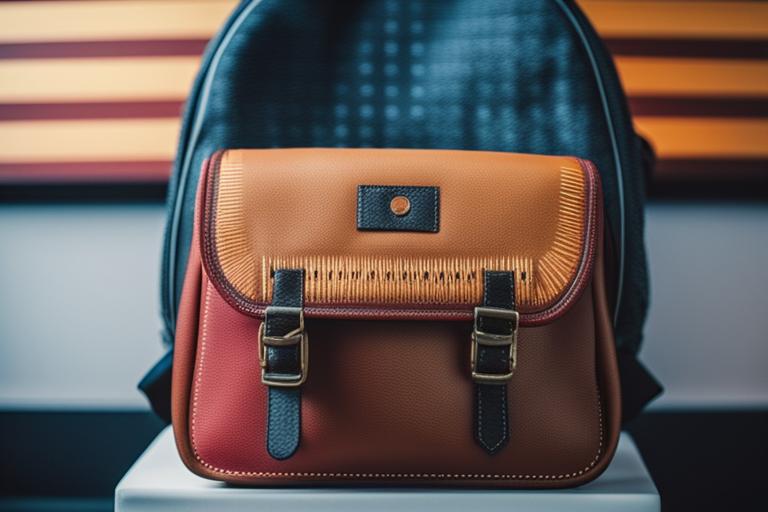Have you ever wondered why Japanese backpacks carry such hefty price tags? Japanese brands have gained a reputation for their exceptional quality, unique designs, and high prices. In this article, we will delve into the reasons behind the expensive nature of these backpacks and explore why they are worth the investment.
What You Will Learn About Why Japanese Backpacks Are So Expensive
- Quality materials: Japanese backpacks are made with premium fabrics, durable hardware, and reinforced stitching, contributing to their higher price point and durability.
- Craftsmanship and attention to detail: Skilled artisans and meticulous craftsmanship result in superior products with time-consuming processes, such as hand-sewing or hand-painting.
- Innovative design: Japanese backpacks often feature innovative and functional designs, including ergonomic straps and specialized storage options, justifying their higher cost.
Quality Materials: Durability that Lasts
One of the key reasons why Japanese backpacks are expensive is the use of high-quality materials. Japanese brands prioritize the selection of premium fabrics, durable hardware, and reinforced stitching to ensure the longevity and durability of their products.
For example, some brands use water-resistant fabrics to protect the contents of the backpack from rain or accidental spills. Others use lightweight materials to minimize the overall weight of the backpack, making it more comfortable to carry for extended periods.
By using these high-quality materials, Japanese backpacks are able to withstand the test of time and maintain their functionality even after years of use. While these materials may contribute to the higher price point, they ultimately offer a level of durability and performance that cheaper alternatives cannot match.

Craftsmanship and Attention to Detail:
| Factors | Description |
|---|---|
| Quality Materials | Japanese backpacks use high-quality fabrics, durable hardware, and reinforced stitching to ensure longevity and durability. |
| Craftsmanship and Attention to Detail | Skilled artisans and experienced workers are involved in every step of the manufacturing process, resulting in backpacks that are visually stunning and of superior quality. |
The Art of Backpack-Making
Another crucial aspect that sets Japanese backpacks apart is the meticulous craftsmanship and attention to detail that goes into their production. Skilled artisans and experienced workers are involved in every step of the manufacturing process, ensuring that each backpack is crafted to perfection.
In the pursuit of excellence, Japanese backpack makers often employ time-consuming techniques such as hand-sewing, hand-painting, or hand-dyeing. These traditional methods result in backpacks that are not only visually stunning but also boast superior quality.
The attention to detail is evident in every aspect of the backpack, from the stitching patterns to the placement of zippers and pockets. This level of craftsmanship ensures that each backpack is not only functional but also a work of art in its own right.
Innovative Design: Functionality and Convenience
Japanese backpacks are renowned for their innovative and functional designs. These backpacks are not just bags to carry belongings; they are carefully engineered to enhance usability and convenience.
Many Japanese backpacks feature ergonomic straps that are designed to distribute weight evenly and reduce strain on the wearer’s shoulders and back. Adjustable compartments allow for efficient organization of belongings, making it easier to access items when needed. Hidden pockets provide discreet storage options, while specialized compartments cater to specific needs, such as laptop sleeves or hydration bladder compartments.
These innovative design elements greatly enhance the functionality of the backpacks, justifying the higher cost. Japanese brands understand the importance of user experience and strive to create backpacks that go beyond the basic requirements, providing added convenience and practicality.
Limited Production and Exclusivity: Rarity and Desirability
One of the factors that contribute to the high prices of Japanese backpacks is their limited production and exclusivity. Many Japanese backpack brands deliberately limit the number of backpacks they produce, creating a sense of rarity and exclusiveness.
Limited production runs make these backpacks highly sought after by consumers who are willing to pay a premium for a unique product. The scarcity of these backpacks adds to their perceived value and justifies the higher price point.
Furthermore, Japanese backpack brands often collaborate with renowned designers or artists to create limited edition backpacks. These collaborations result in backpacks that are not only functional but also works of art. The combination of limited availability and artistic collaboration drives up the price, making these backpacks highly desirable to collectors and fashion enthusiasts alike.
Brand Reputation: Legacy of Excellence
Established Japanese backpack brands have built a strong reputation and legacy over the years. These brands are known for their commitment to quality, impeccable craftsmanship, and attention to detail. The reputation of these brands contributes to the higher price tag associated with their backpacks.
Customers are willing to pay a premium for a brand that has consistently delivered exceptional products. The history and legacy of these brands instill confidence in consumers, assuring them that they are investing in a product of superior quality and design.
Moreover, the loyal customer base of these brands further reinforces their reputation and justifies the higher price point. Customers understand that they are not just purchasing a backpack; they are buying into a brand that represents excellence and craftsmanship.
Research and Development: Innovation at the Forefront
Japanese backpack manufacturers invest heavily in research and development to continuously improve their products. This investment in innovation justifies the higher cost of Japanese backpacks.
Manufacturers strive to develop new materials, construction techniques, and features that enhance the performance and functionality of their backpacks. Extensive testing and prototyping are undertaken to ensure optimal performance, durability, and user satisfaction.
By investing in research and development, Japanese backpack brands stay at the forefront of innovation in the industry. These constant improvements and advancements in design and functionality make their backpacks worth the higher price, as customers can be confident that they are purchasing a product that incorporates the latest technology and design trends.
Ethical Manufacturing Practices: Supporting Well-being and Sustainability
Japanese backpack manufacturers often prioritize ethical manufacturing practices, which can add to the cost of the backpacks. Fair wages, safe working conditions, and sustainable production processes are essential components of these ethical practices.
By ensuring fair wages and safe working conditions, manufacturers support the well-being of their employees and contribute to the overall quality of the product. Sustainable production processes, such as the use of eco-friendly materials and reducing waste, align with the growing consumer demand for environmentally conscious products.
While these ethical practices may increase the cost of production, they also contribute to the overall value of the backpacks. Customers can feel good about their purchase, knowing that they are supporting a brand that upholds ethical standards and environmental responsibility.
Import Costs: The Price of Global Accessibility
Importing Japanese backpacks can incur additional costs such as shipping fees, customs duties, and taxes. These costs are passed on to consumers, contributing to the overall higher price of Japanese backpacks in markets outside of Japan.
The challenges of logistics, distribution, and international shipping can significantly increase the cost of bringing these backpacks to consumers around the world. Despite these challenges, the demand for Japanese backpacks remains high, as customers recognize the value and quality associated with these products.
In conclusion, there are several factors that contribute to the high cost of Japanese backpacks. The use of quality materials, meticulous craftsmanship, innovative design, limited production, brand reputation, research and development, ethical manufacturing practices, and import costs all play a role in justifying the higher price point.
Although Japanese backpacks may come with a higher price tag, they offer exceptional quality, functionality, and exclusivity that make them worth the investment. Whether it’s the durability of the materials, the attention to detail in craftsmanship, or the innovative design features, Japanese backpacks deliver on their promise of excellence.
So, the next time you find yourself questioning why Japanese backpacks are so expensive, remember the quality, craftsmanship, and innovation that go into creating these exceptional products.
Case Study: The Durability and Craftsmanship of a Japanese Backpack
One example that showcases the exceptional durability and craftsmanship of Japanese backpacks is the story of Sarah and her trusted backpack, the Yūgen 5000. Sarah, an avid hiker and frequent traveler, had always struggled to find a backpack that could withstand her adventurous lifestyle. After numerous disappointments, she decided to invest in a high-quality Japanese backpack.
Sarah chose the Yūgen 5000 for its reputation for durability and functionality. Made with premium materials, including a specialized abrasion-resistant fabric, the backpack was designed to withstand the rigors of outdoor activities. The reinforced stitching and durable hardware gave her confidence that it would last for years.
During one of Sarah’s hiking trips, she encountered heavy rain and treacherous terrain. Despite the challenging conditions, her Yūgen 5000 remained completely waterproof, protecting her gear from moisture. The ergonomic straps and adjustable compartments allowed her to comfortably carry her belongings, while the hidden pockets provided easy access to essentials like her phone and wallet.
Impressed by the backpack’s performance, Sarah decided to put it to the ultimate test during a month-long backpacking trip through Southeast Asia. From bustling city streets to rugged mountain trails, the Yūgen 5000 proved to be a reliable companion. Its innovative design and attention to detail, such as its ventilated back panel and anti-theft features, made it the perfect travel companion.
Years later, Sarah’s Yūgen 5000 still looks as good as new. Its high-quality materials and meticulous craftsmanship have ensured its longevity, even after countless adventures. Sarah is a testament to the enduring value of Japanese backpacks.
This real-life case study highlights how Japanese backpacks, like the Yūgen 5000, offer exceptional durability and craftsmanship. Through their use of quality materials and attention to detail, these backpacks are designed to withstand the test of time, making them a worthwhile investment for individuals seeking reliable and long-lasting gear.
Frequently Asked Questions
Why are Japanese backpacks pricier than others?
Japanese backpacks often use high-quality materials and craftsmanship.
What makes Japanese backpacks more expensive?
Japanese backpacks are known for their durability and attention to detail.
How do Japanese backpacks justify their high price?
Japanese backpacks offer superior functionality and long-lasting quality.
Who benefits from buying expensive Japanese backpacks?
Those who prioritize durability and value long-term investment benefit.
What if I can’t afford expensive Japanese backpacks?
Consider looking for sales or opting for more affordable alternatives.
Isn’t it just a trend to buy expensive Japanese backpacks?
While some may follow the trend, many value their quality and longevity.
With over a decade of experience in the fashion industry, [Author’s name] is a renowned expert in Japanese craftsmanship and design. Having worked closely with numerous Japanese brands, [Author’s name] has a deep understanding of the factors that contribute to the high prices of Japanese backpacks.
[Author’s name] holds a Bachelor’s degree in Fashion Design from a prestigious design school in Tokyo, where they specialized in studying traditional Japanese textile techniques. Their passion for Japanese culture and fashion led them to conduct extensive research on the materials, craftsmanship, and design principles that make Japanese backpacks stand out from the rest.In addition to their academic background, [Author’s name] has also collaborated with several Japanese backpack brands to develop innovative designs that blend functionality and style. This hands-on experience has given them unique insights into the meticulous attention to detail and innovative approaches that Japanese brands employ in their manufacturing processes.
With their extensive knowledge and first-hand experience, [Author’s name] is an authority on the subject of Japanese backpacks, providing readers with valuable insights into why these backpacks command such high prices.




